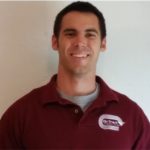The push up is one of those exercises that everyone loves to do, but few athletes or clients do them exceptionally well….
This video goes over three of the most important technical aspects of the movement:
Most people understand the first point. The elbows should be at 45 degree angle or slightly under. Not too in close to the body or flared out really wide either.
Scapula thoracic positioning is a high priority during a push up. Rib cage retracted at the top of the push up with scapula sitting flush on the thorax.
An important part of the serratus is to protract the scapula but also retraction of the rib cage. At the top of the push up, you should not see a medial border prominence of the scapula. At the bottom position of push up the scapula retracts. 
Ensuring the athlete is avoiding hyper extension at the low back and anterior pelvic tilt will go a long ways to help this. The body should move as a unit up and down from the ground. A common analogy I use is “imagine your body as an elevator moving up and down together.” Keeping the position of the torso sturdy with the ribcage stacked over the pelvis helps locks in the mid-section, making it easier to move as a cohesive unit.
A final and often overlooked aspect of a push up is a slight forward lean when dropping down toward the ground so the chest is in line with the hands. Then pushing slightly backwards while pressing back up to the top position so the hands are directly underneath the shoulders. This angle of pressing is very similar to the bar path you should use while doing a bench press.
Pressing back is also an important component that helps the serratus become more active as you are pushing up towards 90 degrees even slightly above at top position of push up. Those who struggle with getting the medial inferior border flush on the thorax tend to benefit greatly from this aspect. As the shoulder moves to 90 degrees of flexion and slightly past the serratus becomes most active. So if you imagine pushing up and back, the shoulder starts moving through more flexion which often results in better usage of the serratus with the exercise.
Most people understand the first point. The elbows should be at 45 degree angle or slightly under. Not too in close to the body or flared out really wide either.
Scapula thoracic positioning is a high priority during a push up. Rib cage retracted at the top of the push up with scapula sitting flush on the thorax.
An important part of the serratus is to protract the scapula but also retraction of the rib cage. At the top of the push up, you should not see a medial border prominence of the scapula. At the bottom position of pushup the scapula retracts.
Ensuring the athlete is avoiding hyper extension at the low back and anterior pelvic tilt will go a long ways to help this. The body should move a unit up and down from the ground. A common analogy I use is “imagine your body as an elevator moving up and down together.” Keeping the position of the torso sturdy with the ribcage stacked over the pelvis helps locks in the mid-section, making it easier to move as a cohesive unit.
 A final and often overlooked aspect of a push up is a slight forward lean when dropping down toward the ground so the chest is in line with the hands. Then pushing slightly backwards while pressing back up to the top position so the hands are directly underneath the shoulders. This angle of pressing is very similar to the bar path you should use while doing a bench press.
A final and often overlooked aspect of a push up is a slight forward lean when dropping down toward the ground so the chest is in line with the hands. Then pushing slightly backwards while pressing back up to the top position so the hands are directly underneath the shoulders. This angle of pressing is very similar to the bar path you should use while doing a bench press.
Pressing back is also an important component that helps the serratus become more active as you are pushing up towards 90 degrees even slightly above at top position of push up. Those who struggle with getting the medial inferior border flush on the thorax tend to benefit greatly from this aspect. As the shoulder moves to 90 degrees of flexion and slightly past the serratus becomes most active. So if you imagine pushing up and back, the shoulder starts moving through more flexion which often results in better usage of the serratus with the exercise.

Dr. Greg Schaible is a physical therapist and strength coach specializing in athletic performance and a regular contributor the the IYCA. Greg is the owner of On Track Physiotherapy and owner of the popular online education resource Sports Rehab Expert. Greg works with athletes and active individuals of all ages. As a former athlete himself, he attended The University of Findlay and competed in both Indoor and Outdoor Track & Field where he earned honors as a 5x Division II All-American and a 6x Division II Academic All-American.
Dr. Schaible was instrumental in putting together the completely updated version of the Youth Athletic Assessment Specialist 2.0 course that covers a wide range of screens, performance assessments, and advanced assessment techniques. Learn more about the YAAS 2.0 by clicking the image below.


